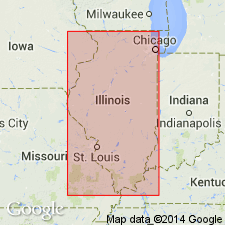
- Usage in publication:
-
- Palestine formation
- Modifications:
-
- Named
- Dominant lithology:
-
- Sandstone
- Shale
- AAPG geologic province:
-
- Illinois basin
Summary:
Palestine formation named. Unit is 75 ft thick, consisting in part of heavy beds of sandstone suitable for building purposes and in part of thinly bedded, ripple-marked sandstones or arenaceous shales, with, locally, argillaceous shales. Unconformably overlies Menard limestone and conformably underlies Clore limestone. Age is Mississippian.
Source: GNU records (USGS DDS-6; Reston GNULEX).
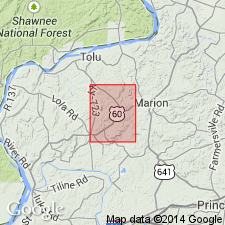
- Usage in publication:
-
- Palestine Sandstone*
- Modifications:
-
- Overview
- AAPG geologic province:
-
- Illinois basin
Summary:
Representative description of Palestine Sandstone in westernmost Kentucky. Upper 25-30 ft is "Shale, mudstone, and siltstone: Shale and mudstone are dark gray; carbonaceous in lower half, basal foot very carbonaceous; in upper part contains siltstone a few feet thick and a few thin silty or sandy lenses; few siderite nodules; rarely crops out." Lower 25-30 ft is "Sandstone and shale: Upper half is light-gray, very fine to fine-grained micaceous, slightly calcareous sandstone, with scattered shaly partings. Lower half is light-gray, very fine grained micaceous sandstone and silty shale in interbeds generally 1/10 to 1/5 inch thick. Unit commonly crops out as thin ledges." Underlain by Menard Limestone; overlain by Clore Limestone.
Source: GNU records (USGS DDS-6; Reston GNULEX).
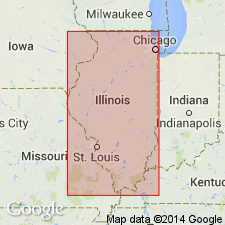
- Usage in publication:
-
- Palestine Sandstone*
- Modifications:
-
- Overview
- Dominant lithology:
-
- Siltstone
- AAPG geologic province:
-
- Illinois basin
Summary:
Current (1975) usage of the Illinois Geological Survey is Palestine Sandstone. "It is a clastic unit that includes sandstone, shale, and siltstone. The Palestine tends to thicken southward. Commonly 50-60 ft thick, but ranges from 25 to 100 ft. Thickest where the massive (channel-phase) sandstone bodies are present. Much of the sandstone is gray, very fine grained, and more or less shaly. The thicker sandstone bodies are lighter colored and coarser grained, and grade to white, medium-grained sandstone. The shale is dark gray and generally silty or sandy. The sandstone bodies lens rapidly in and out, but in most places the sandstone is in the upper and/or lower parts of the formation." Underlain by Menard Limestone; overlain by Clore Limestone. Occurs in southern part of state. Isopach map included.
Source: GNU records (USGS DDS-6; Reston GNULEX).
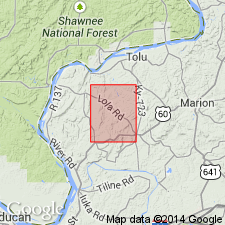
- Usage in publication:
-
- Palestine Formation*
- Modifications:
-
- Overview
- AAPG geologic province:
-
- Illinois basin
Summary:
Palestine Sandstone changed to Palestine Formation for use in small area in westernmost KY. Palestine is "Shale and dolomite: Shale, pale-greenish-gray and reddish-brown, locally silty; few thin interbeds of very fine grained sandstone and siliceous dolomite in middle part of unit; dolomite residuum contains chert nodules." Underlain by Menard Limestone; overlain by Clore Limestone.
Source: GNU records (USGS DDS-6; Reston GNULEX).
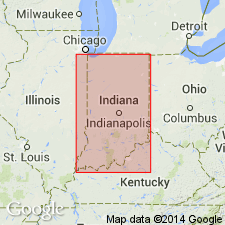
- Usage in publication:
-
- Palestine Sandstone
- Modifications:
-
- Overview
- AAPG geologic province:
-
- Illinois basin
Summary:
Current (1986) usage of the Indiana Geological Survey is Palestine Sandstone of Buffalo Wallow Group. Use of name is "restricted to subsurface use in Indiana where it applies to a somewhat indefinite unit of shale and sandstone that overlies the Menard Limestone and is overlain by the Clore Limestone." Thickness is not indicated. In IN, occurs from Dubois and Knox Cos., southwestward.
Source: GNU records (USGS DDS-6; Reston GNULEX).
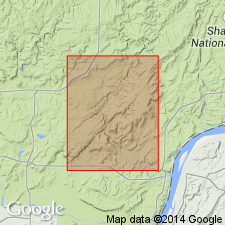
- Usage in publication:
-
- Palestine Sandstone
- Modifications:
-
- Revised
- AAPG geologic province:
-
- Illinois basin
Summary:
The Pope Group, here revised from Megagroup and apparently reinstated, comprises strata from the base of the Aux Vases Sandstone to the top of the Kinkaid Formation, which includes the Palestine Sandstone. According to authors, "The Pope Group is a lithostratigraphic unit distinct from its chronostratigraphic counterpart, the Chesterian Series." The lower boundaries of the two differ slightly. The group is about 1,425 ft thick in the Waltersburg quad, but the lowermost formations, from the Aux Vases Sandstone up to the Fraileys Shale Member of the Golconda Formation do not crop out. This interval is 384 ft thick in the Austin Roberts No. 1 Well. [See subunit list in index portion of Pope summary record. Publication does not name the units between the Aux Vases and the Fraileys and therefore these have not been included in the list.]
Source: GNU records (USGS DDS-6; Reston GNULEX).
For more information, please contact Nancy Stamm, Geologic Names Committee Secretary.
Asterisk (*) indicates published by U.S. Geological Survey authors.
"No current usage" (†) implies that a name has been abandoned or has fallen into disuse. Former usage and, if known, replacement name given in parentheses ( ).
Slash (/) indicates name conflicts with nomenclatural guidelines (CSN, 1933; ACSN, 1961, 1970; NACSN, 1983, 2005, 2021). May be explained within brackets ([ ]).

